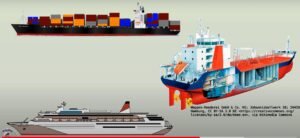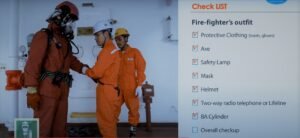
Who is responsible for explaining fire safety procedures to passengers on board the boat?

Fire safety is an important aspect of any cruise. With the unique dangers of being surrounded by water, passengers need to understand fire safety procedures on a boat. This responsibility does not rest solely on one person’s shoulders but is a joint duty involving several key roles within the boat’s crew. In this article, we review the details of fire safety responsibility and explain who is responsible for ensuring passengers are informed and safe.

Captain Role
The Captain is the highest authority on any ship, bearing the ultimate responsibility for the safety of the ship and its passengers. Part of the captain’s duties is to ensure that all crew members are properly trained in fire safety procedures and are competent to brief passengers. The captain must also ensure that fire drills are conducted regularly and that all fire safety equipment is in working order.
Ensuring staff training
A well-trained staff is the first line of defense against any emergency, including fire. The captain must ensure that all crew members receive regular and comprehensive fire safety training. This training includes understanding the types of fires on a boat, the proper use of fire extinguishers, and how to safely evacuate passengers if necessary. The captain’s supervision ensures that each crew member knows their role during an emergency and can guide passengers effectively.
Conducting fire drills
Regular fire drills are an important component of fire safety on a boat. The captain is responsible for scheduling and conducting these drills to ensure that both crew and passengers are familiar with the procedures to follow in the event of a fire. These drills provide an opportunity to practice the use of safety equipment and identify any potential problems with the current fire safety plan.
Role of Chief Officer
The Chief Officer also known as the First Mate, is the captain’s right-hand man and plays an important role in maintaining the safety of the ship. When it comes to fire safety, the chief officer assists the captain in enforcing safety regulations and ensuring all procedures are followed
Supervision of Crew Activities
The Chief Officer oversees the day-to-day activities of the staff, including the implementation of fire safety protocols. This role includes monitoring crew performance during fire drills and providing additional training or guidance as needed. Vigilant supervision by the chief officer helps maintain a high level of readiness among the crew.

Maintenance of Fire Safety Equipment
An essential part of fire safety is ensuring that all equipment is in good working order. The chief officer oversees the maintenance of fire safety equipment, such as fire extinguishers, fire hoses, and smoke detectors. Regular inspections and maintenance help prevent equipment breakdowns during an emergency, ensuring that crew and passengers have the necessary firefighting equipment.
ROLE OF SAFETY OFFICER
On larger ships, a Safety Officer may be appointed to handle specific safety-related tasks, including fire safety. This individual works with the Captain and Chief Officer to develop and implement safety plans, conduct training sessions, and coordinate emergency response.
Developing Fire Safety Plans
The safety officer is responsible for developing comprehensive fire safety plans according to the ship’s specific requirements. These plans outline fire detection and response procedures, as well as the roles and responsibilities of crew and passengers. By having a well-developed plan, the safety officer ensures that everyone on board knows what to do in the event of a fire.
Coordinating Emergency Response
In the event of a fire, the safety officer coordinates response efforts, ensuring that crew and passengers are following established procedures. This coordination includes directing the use of fire extinguishers, supervising the evacuation process, and communicating with the captain and other crew members to effectively manage the situation.
Staff Role
Every crew member has a role to play in fire safety. From deckhands to engineers, everyone should be familiar with fire safety procedures and be able to assist passengers in an emergency.
Assisting Passengers
During an emergency, the crew’s primary responsibility is to assist passengers. This assistance includes guiding passengers to safety, helping them put on life jackets, and making sure they stay calm and follow an evacuation plan. Staff M

1 How do some deep-sea creatures produce their own light, and what purpose does it serve?
Deep-sea creatures produce light through bioluminescence, a chemical reaction in their bodies. This light helps attract prey, communicate with mates, and deter predators.
2 What are some unique architectural features of traditional Japanese houses?
Traditional Japanese houses feature tatami mats, sliding doors (fusuma), and paper screens (shoji). These elements reflect Japan’s cultural values of harmony, simplicity, and adaptation to the environment.
3 What factors have contributed to the rapid spread of invasive species across continents?
Globalization, climate change, and human activities like deforestation have facilitated the spread of invasive species by altering ecosystems and enabling species to move across regions
4 How do space telescopes like the James Webb Space Telescope differ from ground-based telescopes?
Space telescopes are above Earth’s atmosphere, avoiding distortion and light pollution. They can observe a broader range of the electromagnetic spectrum, including ultraviolet and infrared light.
5 Why do some animals engage in altruistic behavior, and how does this benefit them evolutionarily?
Altruistic behavior can enhance an individual’s genetic success through kin selection, reciprocal benefits, and improved social status, thus increasing the survival and reproduction of their genes.

result
Fire safety is an essential component of any cruise. Passengers should be aware of the special hazards associated with being near water, so they should be familiar with fire safety protocols on boats. This shared duty involves multiple key roles within the boat’s crew, rather than one person carrying the entire load. In this post, we delve into the details of fire safety accountability and clarify who is responsible for ensuring passengers are safe and informed.
The role of the captain
As the person responsible for ensuring the safety of the ship and its occupants, the captain is the highest authority on board. The captain’s responsibilities include ensuring that every member of the crew is
